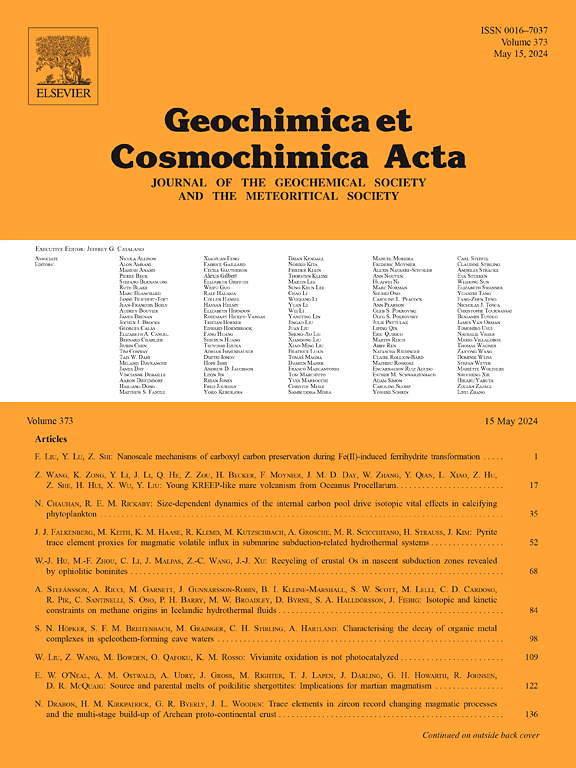Molecular insights into Yb(III) speciation in sulfate-bearing hydrothermal fluids from X-ray absorption spectra informed by ab initio molecular dynamics
IF 5
1区 地球科学
Q1 GEOCHEMISTRY & GEOPHYSICS
引用次数: 0
Abstract
Rare earth elements (REEs) are critical for advanced technologies, yet in hydrothermal aqueous solutions the molecular level details of their interaction with ligands that control their geochemical transport and deposition remain poorly understood. This study elucidates the coordination behavior of Yb3+ in sulfate-rich hydrothermal fluids using in situ extended X-ray absorption fine structure (EXAFS) spectroscopy and ab initio molecular dynamics (AIMD) simulations. By integrating multi-angle EXAFS with AIMD-derived constraints, we precisely resolve Yb3+ coordination structures and ligand interactions under hydrothermal conditions. At room temperature, Yb3+ is coordinated by five water molecules and two sulfate ligands (coordination number, CN = 8), forming a distorted square antiprism geometry. Increasing temperature induces progressive dehydration, reducing the hydration shell and favoring stronger sulfate complexation. At 200°C, sulfate ligands reorganize around Yb3+, shifting its geometry to a capped octahedron (CN = 7). At 300 °C, sulfate binding dominates, leading to structural reorganization that parallels the onset of sulfate mineral precipitation, consistent with the retrograde solubility of REE sulfates. These findings provide direct molecular-scale evidence that sulfate acts as both a transport and deposition ligand, critically influencing REE mobility in geochemical environments. Our results can also help to refine thermodynamic models of REE speciation in high-temperature hydrothermal fluids and improve our understanding of REE ore formation processes in nature.
基于从头算分子动力学的x射线吸收光谱对含硫酸盐热液中Yb(III)形态的分子洞察
稀土元素(ree)对先进技术至关重要,但在水热水溶液中,它们与控制其地球化学运输和沉积的配体相互作用的分子水平细节仍然知之甚少。利用原位扩展x射线吸收精细结构(EXAFS)光谱和从头算分子动力学(AIMD)模拟,研究了Yb3+在富硫酸盐热液中的配位行为。通过将多角度EXAFS与aimd导出的约束相结合,我们精确地解析了热液条件下Yb3+配位结构和配体相互作用。在室温下,Yb3+与5个水分子和2个硫酸盐配体(配位数,CN = 8)配位,形成畸变的方形反棱镜几何。温度升高会导致逐渐脱水,减少水化壳,有利于更强的硫酸盐络合作用。在200°C时,硫酸盐配体围绕Yb3+重组,将其几何形状转变为一个带帽的八面体(CN = 7)。在300 °C时,硫酸盐结合占主导地位,导致结构重组,与硫酸盐矿物沉淀的开始相似,与稀土硫酸盐的逆行溶解度一致。这些发现提供了直接的分子尺度证据,表明硫酸盐作为一种运输和沉积配体,在地球化学环境中对稀土的迁移率有重要影响。研究结果还有助于完善高温热液流体中稀土元素形态的热力学模型,提高对自然界稀土矿形成过程的认识。
本文章由计算机程序翻译,如有差异,请以英文原文为准。
求助全文
约1分钟内获得全文
求助全文
来源期刊

Geochimica et Cosmochimica Acta
地学-地球化学与地球物理
CiteScore
9.60
自引率
14.00%
发文量
437
审稿时长
6 months
期刊介绍:
Geochimica et Cosmochimica Acta publishes research papers in a wide range of subjects in terrestrial geochemistry, meteoritics, and planetary geochemistry. The scope of the journal includes:
1). Physical chemistry of gases, aqueous solutions, glasses, and crystalline solids
2). Igneous and metamorphic petrology
3). Chemical processes in the atmosphere, hydrosphere, biosphere, and lithosphere of the Earth
4). Organic geochemistry
5). Isotope geochemistry
6). Meteoritics and meteorite impacts
7). Lunar science; and
8). Planetary geochemistry.
 求助内容:
求助内容: 应助结果提醒方式:
应助结果提醒方式:


